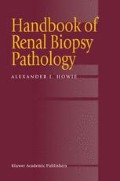Abstract
This means heavy proteinuria associated with hypoalbuminaemia and oedema. The amount of proteinuria required to give the syndrome varies between definitions but is at least 3 g total protein output in the urine per 24 hours. Occasionally proteinuria is in the nephrotic range without the other features of the syndrome. Renal excretory function may be normal or abnormal. There may be haematuria or hypertension. There is hyperlipidaemia as part of the syndrome.
Access this chapter
Tax calculation will be finalised at checkout
Purchases are for personal use only
Preview
Unable to display preview. Download preview PDF.
Further reading: nephrotic syndrome
Brady HR. Fibrillary glomerulopathy. Kidney Internat 1998; 53: 1421–1429.
Cameron JS. Lupus nephritis. J Amer Soc Nephrol 1999; 10: 413–424.
Churg J, Bernstein J, Glassock RJ. Renal disease: classification and atlas ofglomerular diseases. Second edition. New York: Igaku-Shoin, 1995: 152.This gives the 1995 WHO classification of lupus nephritis.
Howie AJ. Segmental sclerosing glomerular lesions. Pediat Nephrol 1993; 7:370–374.
Howie AJ, Lee SJ, Green NJ, et al. Different clinicopathological types of segmental sclerosing glomerular lesions in adults. Nephrol Dial Transplant 1993; 8: 590–599.
Jennette JC, Olson JL, Schwartz MM, Silva FG, editors. Heptinstall’s pathology of the kidney. Fifth edition. Philadelphia: Lippincott-Raven,1998. Chapters 6–10,13,17, 29, 31.
Korbet SM. Primary focal segmental glomerulosclerosis. J Amer Soc Nephrol1998; 9: 1333–1340.
Rennke HG. Secondary membranoproliferative glomerulonephritis. KidneyInternat 1995; 47: 643–656.
Ronco PM. Paraneoplastic glomerulopathies: new insights into an old entity.Kidney Internat 1999; 56: 355–377.
Ruggenenti P, Remuzzi G. Nephropathy of type two diabetes mellitus. J Amer Soc Nephrol 1998; 9: 2157–2169.
Tisher CC, Brenner BM, editors. Renal pathology with clinical and functional correlations. Second edition. Philadelphia: JB Lippincott, 1994. Chapters 8–14,17,41, 44, 46.
Wasserstein AG. Membranous glomerulonephritis. J Amer Soc Nephrol 1997; 8:664–674.
Wright JR, Calkins E, Humphrey RL. Potassium permanganate reaction in amyloidosis. A histologic method to assist in differentiating forms of this disease. Lab Invest 1977; 36: 274–281. This gives details of the method of potassium permanganate pretreatment and Congo red staining.
Author information
Authors and Affiliations
Rights and permissions
Copyright information
© 2001 Kluwer Academic Publishers
About this chapter
Cite this chapter
Howie, A.J. (2001). Indication for biopsy: nephrotic syndrome. In: Handbook of Renal Biopsy Pathology. Springer, Dordrecht. https://doi.org/10.1007/978-94-010-0769-6_6
Download citation
DOI: https://doi.org/10.1007/978-94-010-0769-6_6
Publisher Name: Springer, Dordrecht
Print ISBN: 978-0-7923-6894-6
Online ISBN: 978-94-010-0769-6
eBook Packages: Springer Book Archive

